Tenkara Fishing in Rivers
by Erik Ostrander
Revolutionizing Your Tenkara River Experience
So, you fish with a tenkara rod. It works great on your favorite mountain stream. You can get great drifts in the pocket water and your attractor patterns work amazingly. The fish are pretty, the water is cold, and you’ve got the whole place to yourself. But, you just got invited to fish the Green River in Utah. That’s a whole lot bigger, and with very educated fish.
What are you going to do?
I fished the Green River over three trips before I caught a fish on a fly rod. I kept treating the Green like my local stream, and the fish wanted to have nothing to do with me. It was amazingly frustrating, mostly because the crystal clear waters allow you to see every fish in the river, and with 6,000 to 8,000 fish per river mile that’s a whole lot of frustration!
The top of the A section of the Green River
What did I do? Good question!
To sum it up, I completely revolutionized my fishing perspective, and when I did I started catching fish – and lots of them. Here’s what I did, and what you can do, too:
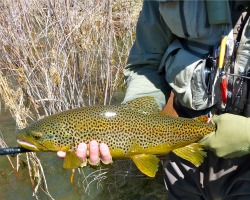
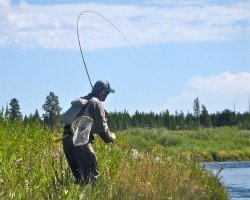
Gear
You're going to need to change up the gear you bring to the river. Your rod, lines, tippet and flies will need to be catered towards longer casts to bigger, picky fish.
The first thing you need for fishing a river is a longer rod – I suggest 13’ as the minimum length you bring to any larger river. The length is needed simply because you may not be able to get close enough to the fish to reach them with a shorter rod. That extra length not only gives you distance to get to fish just out of reach, but is also allows you to keep a longer line off the water, a key technique to detecting strikes and reacting with a quick hook set. My go to rod is the Nissin 2-Way 450ZX in the medium stiffness. You can fish it at 4m (13') or 4.5m (14.5').
Long lines are a must for rivers, but it often comes with a price. The absolute shortest line I fish is 13’, and I usually a longer line than that. However, I won’t go over twice the rod length, and typically end at around 1.5x the rod length. Why? With your long line you’ve got to figure out how to manage landing big fish. Hand lining skills become critical. Big rivers also frequently come with windy conditions, making control of a very long line difficult.
Lots of rivers are fabled for having big fish and big winds. If you can get to the river with no wind you’re in luck, but most likely you’ll have to deal with it at some point. Heavier furled leaders with a strong tip forward taper do best in the wind. So might a heavier size 4 level line. But you’ll sacrifice your ability to keep the line off the water compared to lighter lines. In the windiest conditions, it may be necessary to anchor the end of your line, or even the whole line, in the water, sacrificing some sensitivity to prevent a breeze from pulling your line and fly downwind. Always bring a selection of lines to use for varying conditions such as calm weather requiring delicate presentations, moderate gusty winds, and gale force winds that beg you to reconsider fishing that day.
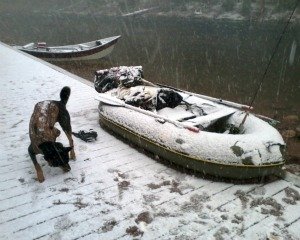
Side note: On a recent multi-day winter trip to Utah’s Green River, the weather was incredibly variable. The first day the weather was described as “nuclear”, as if you were experiencing nuclear fallout ash in the form of gale force snow pounding you and your fly rod. The winds were often strong enough to push the boat up river. But the fishing wasn’t as bad as you’d expect. Between gusts that threatened to knock you over, the wind would calm down enough for the fish to see a midge hatch that was surprisingly prolific. A well-timed cast with a size 22 or 24 midge adult trailed with a midge emerger would often result in a hook up. Line choice was critical. If a gust came up while you were drifting your fly you had to have enough weight to resist the line from being pulled up and ruining your drift. Casting techniques changed as well. Instead of keeping as much line off the water as possible, it was necessary to anchor the line in the water with several feet of line in the water. The wind rippled the surface enough that the fish didn’t spook with a thick furled line coming past them. It’s always important to be flexible with your line and casting when the weather turns for the worse
Tippet selection and length is important to consider on larger waters as well. My tippet length goes up considerably when fishing a river – on average around eight feet of tippet. You’ve got to learn how to cast and properly lay out a tenkara line with that much tippet instead of crumpling it all up in a pile. Fish can be smarter, and know that when they see a tenkara line in the water is usually means that there is also a tenkara angler around, so you’ve got to be able to put your fly far away from anything that isn’t clear. Fluoro will help you sink your fly to the deep depths, and mono floats better. Choose your tippet accordingly. Either way, always, always pack your trash tippet out. Tippet choice is often a personal one, but if you diversify you may find more success.
The last thing you’re going to have to change up is your fly selection. Typically speaking, attractor patterns are going to have lower success. Some tailwater and river fish have PhD’s in entomology and can tell when your fly isn’t just right. They know the difference between midge pupa and midge larvae. It helps to know the bug the fish are eating, the phase they’re keyed in on, and the depth at which they’re eating it. Sometimes they’re not even eating bugs! Scuds, annelids and small fish are a big meal for a trout, and they’ll often take a big meal like a Vladi worm over a size 22 midge larvae. Sometimes it’s the complete opposite. You won’t know until you get there. More on flies and fly selection later.
Reading the water
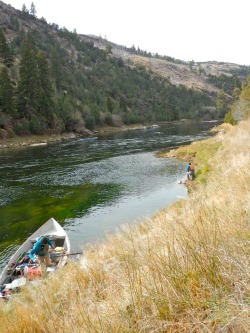
Before you even get to the river, check the flows. Check out the US Geological Survey’s National Water Information System
website. River conditions change daily and sometimes even more often. The flows will tell you whether your river is calmly puttering along at 1200 CFS or raging at 4500 CFS. Different flows mean different fish holding patterns, and different techniques to get them. Typically speaking, at high water the fish will be looking for calm water and may be podded up in eddies. Average water will have the fish spread out. Low water will have fish mostly in the deeper pools. Check the flows and know what to expect when you get to the river.
You can look at a river as a whole lot of small streams put together. You know how to read a small stream right? You fish the eddies, riffles, tongues, and pockets. Well, a big river is all of those things tossed into one huge channel. The eddy may be 50 feet across with froggy water right in the middle collecting bugs all day long. You may find risers in the big eddies even when there is no hatch.
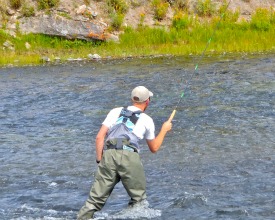
Tongues may be a little more difficult to spot in a river. A tongue is where water gets channeled into a fast current, often with an eddy on each side. Sometimes it’s obvious, and you know you should be fishing the seam of the tongue, or nymphing down deep through the middle of it. But often the river is so large that sub-surface structure creates tongues under 5 feet of water.
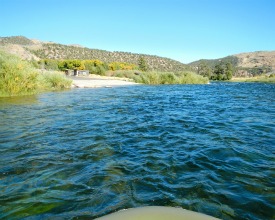
Big rivers often have endless riffles. It can be very confusing to find a place to focus on in a riffle that goes for hundreds of yards. This is where polarized glasses excel. You need to be able to see down to the bottom to detect the subtle differences in water depth and cover. Fish will often hunker down in a small depression where the current is just slightly weaker, allowing them to rest between charges into the stronger current for that passing morsel of food.
Lastly are the pockets. Wait, what pockets? Often times larger rivers do not have obvious pockets. Focus on pillows and subsurface structure. I have found many a trout hiding in four inches of water six inches off the bank in a micro-pocket, just like you’d see on your more familiar mountain stream.
Another important aspect of rivers is depth. Fish will often hold up right at a drop off, or right above one during a hatch. Look for differences in water color to help you find the deep water.
The bigger a river gets, the more featureless it seems to look. Structure is submerged, and the only indication you may have is a small foam line. Look for micro currents, pillows and the eddies to help you out. The concept of treating a river as a whole bunch of small streams put together may seem daunting, but break each piece up and you’ll find fish. You’ll be reading a river like the several small streams that it is in no time.
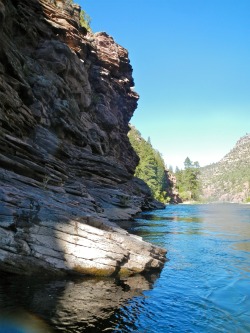
Side note: The Green river is a fairly large river, with flows averaging around 1,200 CFS. However, you can usually treat the banks as small streams flowing differently from the main channel. On one late summer trip to the Green I waded up the bank hitting pockets, making sure to stay inside the bank channel (or, if you will, the small stream between the bank and the main current).
Throwing a big terrestrial pattern yielded 18 fish hooked in less than two hours. Was it because I had the magic fly? No. It was simply because I had the ability to know where a tenkara rod shines and fished water that few western anglers would notice. I was fishing to fish that had rarely been fished to, simply because the water was too hard to fish with western methods.
Covering the water
It’s always easier to catch fish that are eating. Finding fish that are eating can sometimes be hard. Tail-water rivers have consistent yearly temperatures and flows. This means regular hatches that create well fed fish who know all the good hiding spots. They may spook at the feel of a distant footstep rippling through the water, or they may continue to feed nearly at your feet with the bugs you kick up as you wade through the water. Wherever the fish are, you need to find them. Do a lot of walking or floating down river to find fish. You may not always find fish at the surface or they may be down five feet. Finding fish is important, but finding fish that are eating is more important.
The fish in tail-waters and spring creeks are spoiled. Hatches are consistent and often predictable. There is a daily midge hatch on Utah’s Provo River. During the winter it usually happens between 11:00 am and 1:30 pm. If you fish during those hours in the winter, you’ll most likely find a few heads up and stick a couple fish. But try fishing at 1:45 or 2:00 and you’ll just be practicing your cast. If you just want to fish surface flies you may be limited to certain times of day.
Since the fish are spoiled with regular hatches, they tend to be pickier eaters. You may be able to trick a few fish on your attracter pattern or kebari, but you’ll catch more fish and bigger fish if you match the naturals. For some tenkara anglers this is the challenge. How do I apply my traditional techniques to waters they were not designed for? You just accept the limitation. If you catch fewer fish, that’s ok.
So why am I talking about fly patterns in a section called “Covering the Water”? Because fly selection has a huge impact on how deep you fish.
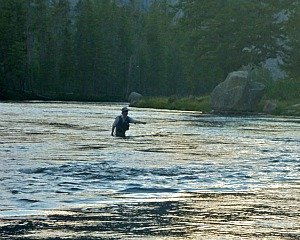
Depth is very important on a river. You may flog the top water all day with your favorite dry fly, flog the river all day with your kebari, then switch to a heavy nymph that gets down to the bottom and start catching more fish than you could have expected. Covering the water not only means walking or floating, it means covering the depths as well.
This is where tenkara shines. Tenkara is a phenomenal tool for covering the shallowest of water to the deepest of water. Well, about 12’ deep is the deepest water I’ve found I can effectively fish with tenkara. But that’s pretty deep!
Covering the water and finding those fish in a huge body of water can be challenging, but it’s always worth it when you have the right tools to put a fly in front of their face.
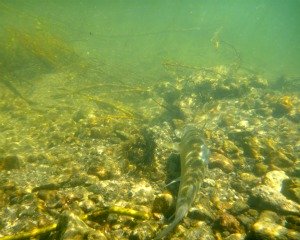
Side note: During the 2011 Tenkara summit we were directed by a local guide to fish a certain area of the Madison River. He gave us a few flies to use and sent us off on our merry way. The fishing began slowly, but as we began to read the water we learned the best technique for finding the fish – it was Czech nymphing with tons of weight. The fish were slammed on the bottom and podded up under strong currents. When we tried to fish elsewhere in the river with other techniques we got the goose egg every time, so we’d go back to Czech nymphing with tons of weight.
The three of us easily landed over 100 fish. The point of the side note isn’t to brag, it’s to show that you have to cover the water and the water depths to find fish. And when you do – fish on!
The Ten Colors of Tenkara
It has been said that if you ask ten traditional Tenkara anglers how they fish they will respond in ten different ways. I propose that if you ask a modern tenkara angler how he fishes he will respond with ten different ways. A tenkara rod in the hands of a competent angler is a very powerful tool.
The Tenkara Guides crew is constantly experimenting with ways to push the limits of tenkara. Where can we take it? What can tenkara do? In some ways we know what tenkara can do and can’t do, but we’re still trying to learn. If you’ll notice, "tenkara" in this article is only capitalized when it’s the traditional technique (or at the beginning of a sentence, or proper noun, but you get my point). Traditional "capital T" Tenkara is very specific; "small T" tenkara can be very broad in its scope.
We’ve been able to expand tenkara to include many techniques:
- Dry fly
- Dry dropper
- Tenkara – aka kebari or one fly philosophy
- Western indicator nymphing
- Swinging soft hackles
- Czech Nymphing
- Spanish Nymphing
- French Nymphing
- High sticking
- Small streamers
It just so happens that I’ve listed ten different techniques, not intentional, but ten different techniques that the modern tenkara angler can use.
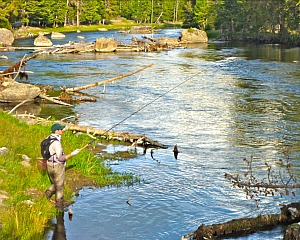
All of these techniques cover the water differently, and to effectively fish a river it helps to know how to apply all of them.
Some of you may cringe with the techniques listed above. Maybe you hate indicators. Split shot may be like arsenic to your soul. But each technique has a specific skill set that can be mastered in its own right. With all of the techniques the essence of tenkara remains – tight lines and controlled drifts where presentation is more important than fly selection.
Pushing the limits of tenkara has revolutionized my fishing perspective. It’s helped me catch more fish and bigger ones, too – more than I ever expected. Tenkara allows me to focus attention on reading the water more effectively, breaking the river up into small streams where I am familiar with the pockets, eddies and tongues. Tenkara also helps me cover water in a way that I’ve never been able to before, because the idea of “Ten Colors” allows me to put a fly in every location of the river I choose. Tenkara, and the concept of Ten Colors, can revolutionize your river fishing experience.

Erik Ostrander loves to fish, and if he wasn’t married he’d fish seven days a week. He began his angling career using western fly fishing techniques, but fell in love with the simplicity and effectiveness of tenkara. Along with Rob Worthing and John Vetterli, Erik formed
Tenkara Guides LLC in 2011 to provide a first rate guiding experience using tenkara fly fishing methods perfectly suited for Utah’s waters. Using a tenkara rod in the 2011 Green River "One Fly" competition, Erik captured second place in the individual honors and led his team to first place in the team competition.
TenkaraBum Home > Tenkara Techniques > Tenkara Fishing in Rivers
“The bitterness of poor quality remains long after the sweetness of low price is forgotten” - Benjamin Franklin
"Be sure in casting, that your fly fall first into the water, for if the line fall first, it scares or frightens the fish..." -
Col. Robert Venables 1662
As age slows my pace, I will become more like the heron.
We've all had situations where seriously chewed up flies kept catching fish after fish after fish. It is no sin to tie flies that come off the vise looking seriously chewed up.
Warning:
The hooks are sharp.
The coffee's hot.
The fish are slippery when wet.
Beware of the Dogma
Seriously, all the hooks sold on TenkaraBum.com, whether packaged as loose hooks or incorporated into flies, are sharp - or as Daiichi says on their hook packages, Dangerously Sharp. Some have barbs, which make removal from skin, eyes or clothing difficult. Wear eye protection. Wear a broad-brimmed hat. If you fish with or around children, bend down all hook barbs and make sure the children wear eye protection and broad-brimmed hats. Be aware of your back cast so no one gets hooked.
Also, all the rods sold on TenkaraBum.com will conduct electricity. Do not, under any circumstances, fish during a thunder storm. Consider any fishing rod to be a lightning rod! Fishing rods can and do get hit by lightning!
What's in stock?
Kurenai II AR 30F
Kurenai II AR 33F
Kurenai II AR 39F
TenkaraBum 33
TenkaraBum 36
Furaibo TF39
Furaibo TF39TA
Nissin Oni Tenkara Line
If you enjoy spin fishing or baitcasting please visit my sister site Finesse-Fishing.com.
